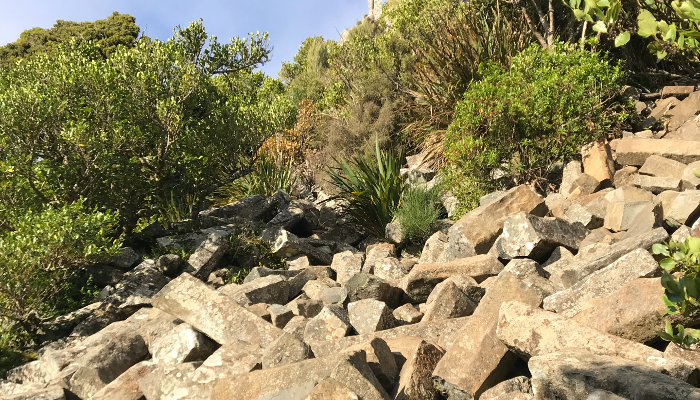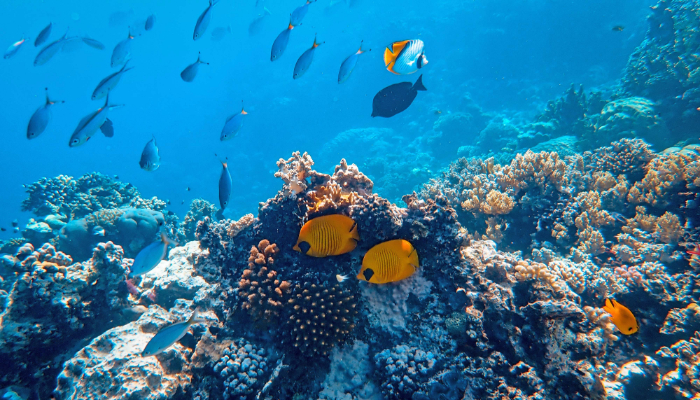Rocky shore (New Zealand)
Where can I find information about the rocky shore?
(Years 5-8)

Image: Rock Crustacean Rocks by barskefranck on pixabay.
Entry last updated: 10/07/25
Introduction
The rocky shore is a unique part of New Zealand's coastline and is a habitat which is home to many sea creatures, and shorebirds. The rocky shore is also at risk from man-made problems like climate change, pollution and loss of habitat.
Rocky shore life
Here is a list of some of the creatures you might find on the rocky shore:
Crustaceans: crabs, crayfish (kōura), lobsters and barnacles that live in the sea. They have a hard covering or shell, two feelers or antennae, and large pincers or claws.
Echinoderms: starfish, sea cucumbers, sea urchins (kina). They have spiny skin and have no backbone to hold them up, so they appear to crawl on the ocean floor.
Sea Slugs: live in rock pools. They are often grouped with shellfish even though they have no shell.
Shellfish: pāua, pipi, cockles (tuangi), tuatua, mussels (kuku or kūtai), oysters (tio), catseyes (pūpū), mud snails (whetiko).
Sea birds: seagulls, gannets, petrels and shags are some of the sea birds that inhabit the coast of New Zealand.
Te Ara: The Encyclopedia of New Zealand
Te Ara is an excellent starting point for all questions about Aotearoa New Zealand. Te Ara has heaps of information about life in and around the ocean.
Go to the Sitemap and look for Section: Earth, Sea and Sky.
Then choose Sea Life.
Choose a page about rock shore creatures like crustaceans, shellfish, starfish, or plants like seaweed!
For information about birds that make their home around the seashore, from the Sitemap, choose Birds of Sea and Shore.
You can also use Te Ara to look for specific creatures by using the name of the creature as your keyword in the search bar.
Tips: Te Ara: The Encyclopedia of New Zealand belongs to the Ministry for Culture and Heritage. We can tell that it a government organisation because it has .govt in the address, so information is well-researched and reliable.
Otago University Marine Studies Centre
This page has information about research the University of Otago is doing about the sea and sea life. It has lots of cool resources you can download.
Go to the heading Learn with us and select Check out our education resources.
Then select Resources to download.
Scroll down the list and look for anything that says 'rocky shore' - there's heaps!
There are specific fact sheets for the rocky shore in both the North Island and South Island.
This site also comes from the Otago University Marine Studies Centre. The word marine means 'relating to, or found in the sea' so marine life is another name for sea life. This marine life database is great for finding out about marine animals and plants.
Go to Search by Habitat.
Then Rocky shore intertidal for a list of all the different creatures you can find on the shore.
Select a picture for more facts about the animals' identification, habitat and diet.
Tips: We like this website because it comes from Otago University, so the information will be well researched and reliable. You can tell that this is a website from an educational organisation because it has .ac in the web address.
Habitat and ecology of the rocky shore
A habitat is the home or environment of an organism (like a plant or an animal). Ecology is a part of biology that studies how plants and animals interact with each other and their habitat. There are lots of different habitats on the rocky shore. These can be broken up into different zones where different plants and animals live.
These zones are:
The splash zone, or supratidal zone: the area above the tide line that still gets splashed by waves, but isn't under water.
Intertidal zone: divided into the high tide zone, the middle tide zone, and the low tide zone.
Subtidal zone: the area that is always covered by water.
Te Ara: The Encyclopedia of New Zealand
Te Ara also describes New Zealand's coastal habitats like shores, dunes, beaches and rock pools and what lives in each of these places.
Go to Topics and select Geography.
Choose Coastal shoreline.
Explore rock pools and boulder shores to read about the purple shore crab and anemones that are found here.
You can select Images and Media to find pictures like this diagram Zones of a rocky shore.
It shows some of the animals and plants you can find in each zone.
This website created by the University of Waikato and Curious Minds has lots of articles, videos and activities on different science topics.
Use the search bar at the top of the page and enter 'rocky shore'.
You will find an article called Living World — The rocky shore that shows the different zones and sea life found here.
Tips: Websites that have .org or .net in the address can have good information, but you need to assess how reliable it is. Check the About us link on the website, if you can find one. That can tell you what the organisation’s mission and values are.
This is a searchable website with lots of information on marine and coastal life and issues. A group of European marine institutes created it, so the information will not be specific to New Zealand. However, the information on the rocky shore is very good.
Enter 'rocky shore' into the search bar and look for Rocky shore habitat.
The page has links to the different zones of the rocky shore, problems and adaptations, and also why rocky shores are important.
Tips: Search words, or keywords, are the most important words in our question. Usually it’s better to leave out small words like ‘the’, ‘a’ and ‘of’ and just choose the main ones, eg [rocky shore]. We can always change our keywords or add more if we need to.
Human impact and conservation
Climate change, oil spills and ocean pollution have had a huge impact on the rocky shore. Let us look at how this happens and what we can do to conserve this environment.
Te Ara: The Encyclopedia of New Zealand
There is plenty of information about conservation and pollution of our ocean environment on Te Ara.
Go to Topics and choose Conservation.
Read the story about Marine Conservation which is a good introduction to some of the laws that protect our marine environment.
The page on Pollution talks about the causes of our ocean pollution
Tips: Remember that 'marine' means the habitat from the shore and right out into the ocean, so there will be information about the habitat and animals that live in much deeper water too!
This is the website of the government organisation responsible for the protection of New Zealand's marine habitat.
From the homepage, look for the heading Public and go to Information for Schools.
Here you can find out about what kinds of pollution hurt our waters, what laws there are in place to help, and how you can get involved.
Or from the homepage, go to Public.
Now choose Environmental protection.
Here you can find out about the impact of oil and waste on our waters and how New Zealand responds to oil spills in our waters.
Also known as DOC, the Department of Conservation is the government agency that looks after New Zealand's natural environment.
Go to Nature at the top of the page, then choose Habitats.
Look down the page to Marine to find links to marine reserves and protected areas marked for conservation by DOC.
You will also find links to marine biology, marine mammals, and seabirds.
Tips: These websites (Te Ara, Maritime New Zealand, Ministry for the Environment, DOC) are from government organisations. We like sites like this because they’re reliable. You can tell because of their web address – they have a .govt in their web address. They’re also New Zealand sites, so relevant for us.
Books
There are some great books about the rocky shore - check out your local public or school library to see what they have.
Some recommended titles are:
New Zealand seashore wildlife by Dave Gunson.
All about New Zealand's seashore by Dave Gunson.
At the beach: explore & discover the New Zealand seashore by Ned Barraud.
Rocky shores by Kimberley Jane Pryor.
Rocky shore by Brian O'Flaherty.
SCIS no: 1832731
Topics covered
Related content

Rocks & minerals
Where can I find information about rocks and minerals?

Islands (New Zealand)
Where can I find information about New Zealand islands?

Conservation (NZ)
Where can I find information about conserving the natural environment in New Zealand?

Stones & shells (New Zealand)
Where can I find information about New Zealand's precious stones and shells?

Rivers (New Zealand)
Where can I find information about rivers in New Zealand?

Oceans
Where can I find information about oceans?

Animals
Where can I find information about different animals?

Tides (junior)
Where can I find information about tides?
